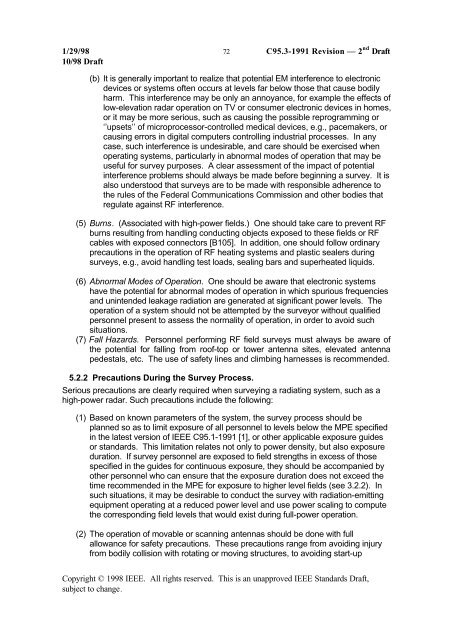DRAFT Recommended Practice for Measurements and ...
DRAFT Recommended Practice for Measurements and ...
DRAFT Recommended Practice for Measurements and ...
Create successful ePaper yourself
Turn your PDF publications into a flip-book with our unique Google optimized e-Paper software.
1/29/98 72 C95.3-1991 Revision — 2 nd Draft<br />
10/98 Draft<br />
(b) It is generally important to realize that potential EM interference to electronic<br />
devices or systems often occurs at levels far below those that cause bodily<br />
harm. This interference may be only an annoyance, <strong>for</strong> example the effects of<br />
low-elevation radar operation on TV or consumer electronic devices in homes,<br />
or it may be more serious, such as causing the possible reprogramming or<br />
‘’upsets’’ of microprocessor-controlled medical devices, e.g., pacemakers, or<br />
causing errors in digital computers controlling industrial processes. In any<br />
case, such interference is undesirable, <strong>and</strong> care should be exercised when<br />
operating systems, particularly in abnormal modes of operation that may be<br />
useful <strong>for</strong> survey purposes. A clear assessment of the impact of potential<br />
interference problems should always be made be<strong>for</strong>e beginning a survey. It is<br />
also understood that surveys are to be made with responsible adherence to<br />
the rules of the Federal Communications Commission <strong>and</strong> other bodies that<br />
regulate against RF interference.<br />
(5) Burns. (Associated with high-power fields.) One should take care to prevent RF<br />
burns resulting from h<strong>and</strong>ling conducting objects exposed to these fields or RF<br />
cables with exposed connectors [B105]. In addition, one should follow ordinary<br />
precautions in the operation of RF heating systems <strong>and</strong> plastic sealers during<br />
surveys, e.g., avoid h<strong>and</strong>ling test loads, sealing bars <strong>and</strong> superheated liquids.<br />
(6) Abnormal Modes of Operation. One should be aware that electronic systems<br />
have the potential <strong>for</strong> abnormal modes of operation in which spurious frequencies<br />
<strong>and</strong> unintended leakage radiation are generated at significant power levels. The<br />
operation of a system should not be attempted by the surveyor without qualified<br />
personnel present to assess the normality of operation, in order to avoid such<br />
situations.<br />
(7) Fall Hazards. Personnel per<strong>for</strong>ming RF field surveys must always be aware of<br />
the potential <strong>for</strong> falling from roof-top or tower antenna sites, elevated antenna<br />
pedestals, etc. The use of safety lines <strong>and</strong> climbing harnesses is recommended.<br />
5.2.2 Precautions During the Survey Process.<br />
Serious precautions are clearly required when surveying a radiating system, such as a<br />
high-power radar. Such precautions include the following:<br />
(1) Based on known parameters of the system, the survey process should be<br />
planned so as to limit exposure of all personnel to levels below the MPE specified<br />
in the latest version of IEEE C95.1-1991 [1], or other applicable exposure guides<br />
or st<strong>and</strong>ards. This limitation relates not only to power density, but also exposure<br />
duration. If survey personnel are exposed to field strengths in excess of those<br />
specified in the guides <strong>for</strong> continuous exposure, they should be accompanied by<br />
other personnel who can ensure that the exposure duration does not exceed the<br />
time recommended in the MPE <strong>for</strong> exposure to higher level fields (see 3.2.2). In<br />
such situations, it may be desirable to conduct the survey with radiation-emitting<br />
equipment operating at a reduced power level <strong>and</strong> use power scaling to compute<br />
the corresponding field levels that would exist during full-power operation.<br />
(2) The operation of movable or scanning antennas should be done with full<br />
allowance <strong>for</strong> safety precautions. These precautions range from avoiding injury<br />
from bodily collision with rotating or moving structures, to avoiding start-up<br />
Copyright © 1998 IEEE. All rights reserved. This is an unapproved IEEE St<strong>and</strong>ards Draft,<br />
subject to change.
















